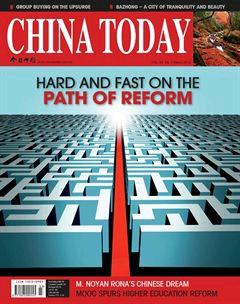Sci-Tech
Top Ten Sci-Tech Advances of 2013
On January 24, the Chinese Academy of Sciences (CAS) and the Chinese Academy of Engineering (CAE) unveiled their selection of the top 10 domestic and international advances in science and technology of 2013.
The top 10 advances in science and technology of 2013 in China are: the soft-landing of Change-3 on the moon; the successful launch of the Shenzhou-10 spacecraft; the discovery of the quantum anomalous Hall effect in experimentation; tracing the source of H7N9 avian flu and making important breakthroughs in studying inter-species transmission of H5N1 avian flu; Tianhe-2 remaining the worlds top supercomputer; successful development of the worlds lightest material; development of the worlds only practical deep-ultraviolet diodepumped solid-state laser; ultra-high resolution Raman imaging of a single molecule; the development of a nuclear power generator with the worlds largest unit capacity; and the worlds first mimicry computer.
The top 10 international advances in science and technology of 2013 are: the flight of a man-made space probe outside the solar system; the first viable living tissue created from a 3D printer; development of the worlds first carbon nanotube computer; proving the existence of four-stranded human DNA structures; the discovery of high-energy cosmic neutrinos; successful cultivation of human embryonic stem cells; the first use of the worlds biggest astronomical telescope; the first ultrahigh definition 3D atlas of the human brain; the first longrange control between two human brains; and the launch of 32 satellites with one rocket.
This is the 20th selection made by the CAS and CAE, aiming to make knowledge of domestic and international development in science and technology more accessible to the public.
U.K. Genomic Research Leader to Launch AsiaPacific Center
The Wellcome Trust Sanger Institute, a British genomic research center and leader in the Human Genome Project, will establish an Asia-Pacific resource center at Soochow University, Suzhou Industrial Park. The center will play a pivotal role in boosting Chinas advances in bioscience, medicine and pharmaceuticals. The total investment of the project is RMB 100 million, with an upfront cost of RMB 40 million. This transnational cooperation project marks the highest level of international cooperation in the field of life sciences to date. Based on the resources of the Sanger Institute, the center will set up a stem cell resource center and a platform for deciphering mouse genome function to broaden biomedical development and research at the industrial park. It is hoped that the center will optimize the sharing of resources between Asia and Europe, synchronizing the industrial parks research and development with the world. The Sanger Institute was founded in 1993 by the Wellcome Trust and the U.K.s Medical Research Council. Its outstanding contribution has been to develop the mouse gene knockout resource, which won the 2007 Nobel Prize in Physiology or Medicine.
China to Industrialize Sea Ice Desalination
On January 14, a research team from Beijing Normal University signed a sea ice desalination technology transfer agreement worth RMB 7.5 million with Beijing Huahaideyuan Technology Co., Ltd.
“Unlike sea water desalination, our unique work is to extract fresh water from sea ice,” said Professor Gu Wei, head of the research team. The Circum-Bohai Sea Region is dense in population but less so in precipitation, therefore, fresh water resources there are in critical supply. The Bohai Sea, a gulf on the coast of northeastern China that freezes during winter, is located at the lowest latitude of its kind in the world. Launched in 1995, the research team has uncovered the basic principles and technology of sea ice desalination and developed the necessary equipment for the process, including an icebreaking platform and an icegatherer.
“The cost of desalinated water has dropped from RMB 6 to RMB 5 per ton, and for mass production the price is expected to be less than RMB 4 per ton,” said Gu. “Moreover, the technology produces zero emissions during the entire process, solving the problem of bittern release.”
According to Gu, sea ice has been regarded as a natural disaster, threatening fixed drilling platforms and shipping traffic. The technology will turn this danger into a valuable resource.
RMB 2.748 Billion
Ministry of Finance data show that the central budget allocated RMB 2.748 billion to 292 key Chinese laboratories so taking total central government funding for these facilities to RMB 17.33 billion. Of this amount, in 2013 RMB 2.072 billion went towards research and the rest paid for the purchase and upgrading of equipment and apparatus.
Discovery of Chinas Earliest Math Document
Chinese archeologists announced the discovery of the countrys earliest mathematics document dating back more than 2,200 years. The document named “Suan Biao”(calculating chart) comprises 21 bamboo slips from the Eastern Zhou Dynasty (770-221 BC), four of which are incomplete, but analysts are confident that this content can be retrieved. The calculating tool can turn multiplication into addition, and used in division and extraction of the square root. This tool makes it easy to get the product of any two whole numbers under 100. The document is the earliest of its kind discovered in China. Its mathematics and calculating functions are considered to have been advanced worldwide in its time, and its discovery is important for the mathematical history of China and the world.

